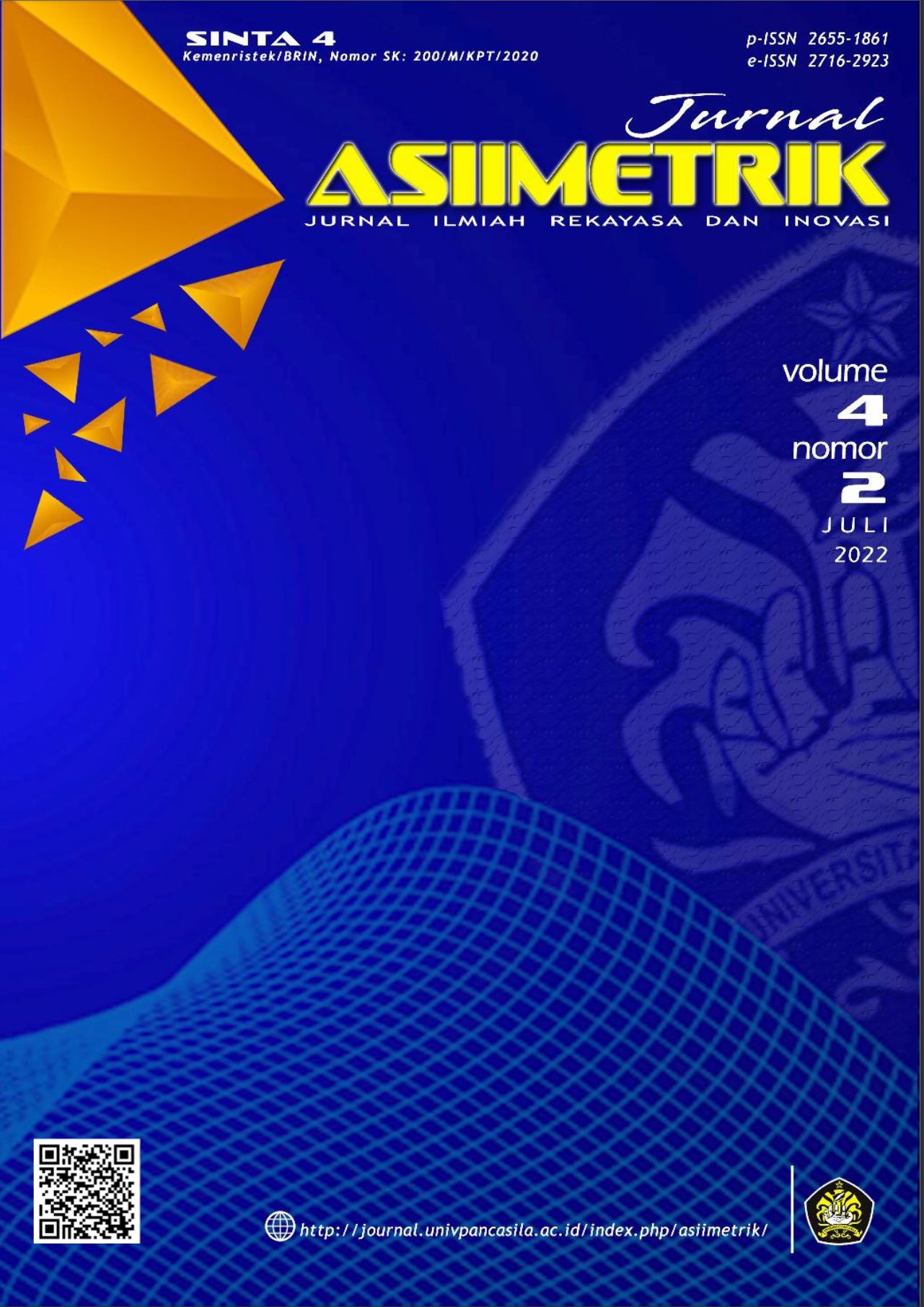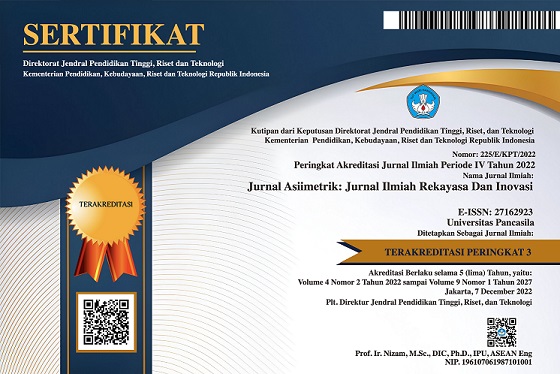Characterization of the Co-Flow Jet Effect as One of the Flow Control Devices
DOI:
https://doi.org/10.35814/asiimetrik.v4i1.3437Keywords:
aerodynamic performance, co-flow jet, flow control, NACA 0015, separationAbstract
The computational study discusses the application of the co-flow jet technique as a fluid flow control device on the NACA 0015 airfoil. The numerical equation used is the RANS equation with the k-ε turbulence model. There are three variations of the mesh proposed in this paper. The first variation is a fine mesh with 100,000 elements. The second variation is a medium mesh with 50,000 elements. Meanwhile, the third variation is coarse mesh with 25,000 elements. Based on the mesh independence test results, the mesh with the lowest error value is the fine mesh. Co-flow jet is proven to control fluid flow on the upper side of NACA 0015. Co-flow jet can also improve the aerodynamic performance of NACA 0015 by increasing Cl and decreasing Cd. The increase in Cl was 114% and the decrease in Cd was 24%. The fluid flow separation on the upper side of the airfoil can also be handled well by the co-flow jet.
Downloads
References
Aftab, S.M.A. and Ahmad, K.A. (2017) ‘Correction: CFD study on NACA 4415 airfoil implementing spherical and sinusoidal Tubercle Leading Edge’, Plos one, 12(11), p. e0188792.
Bertagnolio, F. (2008) ‘NACA0015 measurements in LM wind tunnel and turbulence generated noise’. Denmark.
Cable, M. (2009) An evaluation of turbulence models for the numerical study of forced and natural convective flow in Atria. PhD Thesis. Queen’s University.
Harinaldi et al. (2019) ‘The comparison of an analytical, experimental, and simulation approach for the average induced velocity of a dielectric barrier discharge (DBD)’, in AIP Conference Proceedings. AIP Publishing LLC, p. 020027.
Harinaldi, Budiarso and Julian, J. (2016) ‘The effect of plasma actuator on the depreciation of the aerodynamic drag on box model’, in AIP Conference Proceedings. AIP Publishing LLC, p. 040004.
Harinaldi, K.M.D. et al. (2020) ‘Flow control with multi-dbd plasma actuator on a delta wing’, Evergreen, 7(4), pp. 602–608.
Hu, Q. et al. (2020) ‘Experimental and numerical investigation on the transport characteristics of particle-fluid mixture in y-shaped elbow’, Journal of Marine Science and Engineering, 8(9), p. 675.
Julian, J. et al. (2018) ‘Effect of plasma actuator in boundary layer on flat plate model with turbulent promoter’, Proceedings of the Institution of Mechanical Engineers, Part G: Journal of Aerospace Engineering, 232(16), pp. 3001–3010.
Julian, J., Difitro, R. and Stefan, P. (2016) ‘The effect of plasma actuator placement on drag coefficient reduction of Ahmed body as an aerodynamic model’, International Journal of Technology, 7(2), pp. 306–313.
Julian, J. and Karim, R.F. (2017) ‘Review: Flow control on a squareback model’, International Review of Aerospace Engineering, 10(4), pp. 230–239.
Karim, R.F. and Julian, J. (2018) ‘Drag reduction due to recirculating bubble control using plasma actuator on a squareback model’, in MATEC Web of Conferences. EDP Sciences, p. 01108.
Kosasih, E.A., Karim, R.F. and Julian, J. (2019) ‘Drag reduction by combination of flow control using inlet disturbance body and plasma actuator on cylinder model’, Journal of Mechanical Engineering and Sciences, 13(1), pp. 4503–4511.
Megawanto, F.C. et al. (2018) ‘Numerical analysis of plasma actuator for drag reduction and lift enhancement on NACA 4415 airfoil’, in AIP Conference Proceedings. AIP Publishing LLC, p. 050001.
Megawanto, F.C. et al. (2019) ‘Flow separation delay on NACA 4415 airfoil using plasma actuator effect’, International Review of Aerospace Engineering, 12(4), pp. 180–186.
Roache, P.J. (1994) ‘Perspective: a method for uniform reporting of grid refinement studies’, J. Fluids Eng., 116(3), pp. 405-413.
Srinivasan, S., Ahmed, T. and Sanjana, G.K. (2019) ‘Numerical and Experimental Investigation of Co-Flow Jet Technique in Clarky-M18 Aerofoil’, in Proceedings of the Second International Conference on Emerging Trends in Science & Technologies For Engineering Systems (ICETSE-2019).
Sudhakar, S. and Karthikeyan, N. (2021) ‘Flow Separation Control on a NACA-4415 Airfoil at Low Reynolds Number’, in Proceedings of 16th Asian Congress of Fluid Mechanics. Springer, pp. 323–334.





























